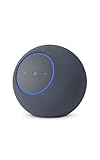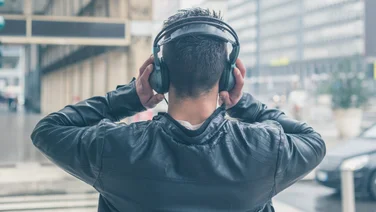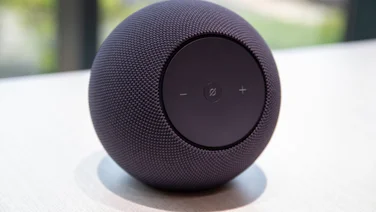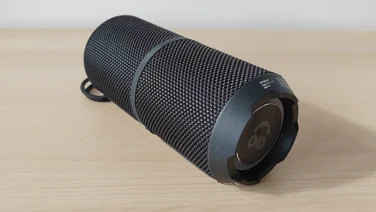To help us provide you with free impartial advice, we may earn a commission if you buy through links on our site. Learn more













- Great immersive sound quality
- Fresh new compact design
- Fast and responsive Alexa
- No physical connections
- Alexa+ not available in UK at launch
It’s hard to argue that Amazon’s Echo speakers have enjoyed most of their success thanks to aggressive pricing and regular discounts. As a result, Echo speakers have found their way into many homes, a strategy that has seen Amazon dominate smart speaker sales, with the Echo Dot being the most popular.
The 2019 launch of the Echo Studio raised a few eyebrows. It was pushed more as an audiophile speaker, supporting high-resolution music as well as spatial audio, a relatively new format at the time. Alongside the launch of the Echo Studio, Amazon Music stepped up to provide that higher quality music.
Jump to 2025 (via a fairly subtle update in 2022) and Amazon has delivered a significant overhaul of perhaps its most unlikely speaker. The Echo Studio 2nd Gen picks up the baton, continuing the drive towards higher-quality music, still offering spatial audio (and still only from Amazon Music), but in a more compact design.
It sits in a line-up of Echo speakers that’s slimmed down this year. With the similarly-sized Echo 4th Gen now discontinued, it feels like Amazon is positioning the Echo Studio where that speaker used to sit, instead of replacing the larger, beefier Echo Studio 2022.
What do you get for the money?
The new Echo Studio comes with a higher price of £220, and a completely new design. It looks the same as the Echo Dot Max: a sphere wrapped in mesh, with a concave control section on the front, looking a little like the Death Star. It’s 40% smaller than the old, cylindrical Echo Studio.
The Echo Studio measures 155mm wide and only comes in the Graphite colour. Those with longer memories might remember that the previous model only came in one colour until the 2022 update, which gave rise to a white version.













Sitting inside that shell is a 3.75in, high-excursion woofer to provide the bass and three 3.25in full-range drivers. These are positioned to fire left, right and upwards, with a 3.1.1 channel arrangement (left, centre, right, height, subwoofer). That’s how it will support Dolby Atmos and other spatial audio formats.
There are no physical connections on the Echo Studio, but Wi-Fi has been improved to support WiFi 6E and is joined by Bluetooth 5.3, Zigbee, Matter and Thread to support smart home builders. It’s Eero compatible, so can act as a hub to extend an existing Eero mesh network if you have one at home. Smart home fans might also be interested in the on-board temperature sensor, which can provide a little more information about the room it is placed in.













Controls are accessed via the panel on the front, with a mute for the mic and volume up and down, and you can also tap the top of the speaker to pause and resume music, dismiss timers and snooze alarms, and end calls and drop-ins. The controls are ringed by Alexa’s lights, showing blue when you’re in conversation with the digital assistant, and other colours reflecting the status of the speaker.
Amazon has said the Echo Studio is “designed for Alexa+”, the AI-enhanced version of its voice assistant, but that’s not yet available in the UK; it’s expected in 2026. Additionally, the Echo Studio will play its part in an Alexa Home Theater, but that function also isn’t yet available.
What did we like about it?
The Echo Studio delivers on its promise of offering high-quality audio, with that comprehensive set of drivers meaning there’s real substance to the audio output, throughout the volume range.
It’s not as capable when it comes to bass delivery as the previous model, but it compensates with an open and wide sound that’s super impressive for a speaker of its size. This is especially noticeable when streaming higher quality tracks – including Dolby Atmos – from Amazon Music.













The Echo Studio is much better for delivering room-filling audio than the Echo Dot Max, providing great clarity and clear vocals and, in general, it’s a pleasure to listen to. I also found that it sounds good at lower volume levels, and doesn’t distort when the volume is cranked right up.
Voice commands were easily detected and responses were fast, even without the enhancement that Alexa+ is set to bring. Currently, Alexa is much as it was: best suited to smart home control, playing music from the wide range of sources it offers, and providing snippets of information here and there, but the language it uses is formulaic and feels outdated in the AI era.
I like the more compact design; it sits more discreetly in your home than the previous model. The physical controls are easy to use, too, and it’s extra weight means it doesn’t move around when you poke the buttons like the Echo Dot Max does.













Using the Alexa app it’s possible to stereo pair the Echo Studio, and in the near future you’ll also be able to create a home cinema system that will work with the Fire TV Stick 4K, Fire TV Stick 4K Max and Fire TV Cube. That’s currently not enabled, but is promised “soon”.
Stereo pairing and easy grouping is something Echo speakers are good at, but the Echo Studio feels like it would be formidable as a stereo pair, while also not taking up too much space in a room.
What could it do better?
Anyone looking for a repeat performance of the original Echo Studio is going to be disappointed. It simply can’t compete with that speaker when it comes to sheer muscle. The old Echo Studio had a 5.25in down firing woofer, which produced organ-shaking bass, and that doesn’t happen here.
Arguably, the audio is now better balanced, but the thing I liked the most about the old Echo Studio was slipping a finger into the bass port to feel the cone vibrating. Purely personal taste, but that sort of edgy excitement is lacking in the new Echo Studio.













In fact, I’d almost go as far as saying that the new Echo Studio is closer to being an Echo Max – as it’s similar in size and format to the Echo 4th Gen. It’s more than double the price of that speaker, however.
I’m not a huge fan of the placement of the light ring on the front of the speaker, either. It means you can’t see the response unless you’re in front of the speaker. The old model had the lights around the top, which were much easier to see.
And there are no physical connections this time around, so you can’t connect a cable to ensure that you’re getting top quality from the speaker. But in a world where streaming now dominates, only a few are going to want that sort of feature. After all, you can’t do that with the Sonos Era 300, one of the best sounding smart speakers you can buy.
Finally, the lack of Alexa+ in the UK (at the time of writing) potentially takes some of the shine off the Echo Studio, but that enhanced voice interaction is expected in 2026.
Should you buy the Echo Studio (2025)?
Despite its flaws, I do like the new Echo Studio. It has a wider soundstage, cleaner output and better bass than the smaller Echo Dot and Echo Dot Max speakers, and if you want to fill a room with music and plenty of volume, it’s a better speaker than anything else in Amazon’s range.
While it’s expensive for an Echo and pricier than the speaker it replaces, the price is modest when compared to the likes of the Apple HomePod (£299) or Sonos Era 300 (more than £400). That gives the Echo Studio appeal, and while it’s not the bass driving beast that the previous Studio was, it’s still a great speaker.




















